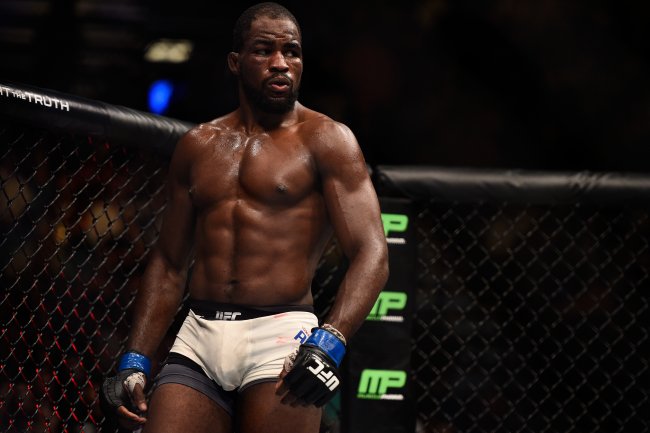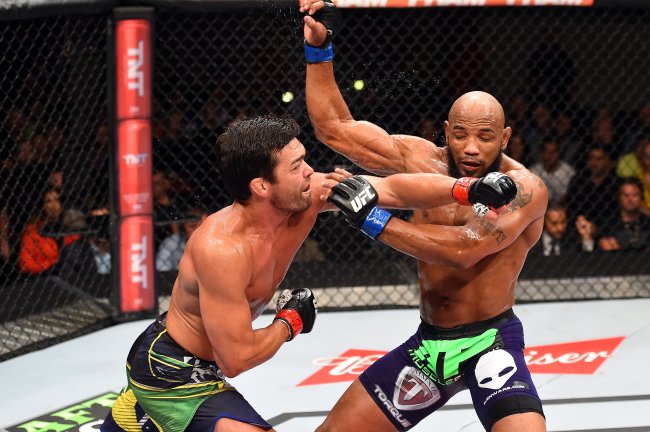Bellator's four-man, one-night light heavyweight tournament marks a major step for MMA's second-biggest promotion. It is pure Scott Coker, an ode to spectacle and a throwback to a bygone age of the sport.
This tournament is by far the best use of Bellator's limited resources at 205 pounds. It creates fresh matchups and buzz after a stagnant series of rematches—Emanuel Newton has defeated Muhammed "King Mo" Lawal twice and Linton Vassell once—and it is an effective way to introduce their big new signing, former UFC competitor Phil Davis.
The world's largest promotion let Davis go to Bellator when his contract ran out. The UFC made a token attempt to re-sign the former Penn State wrestling great, but when its competitor made a better offer, the UFC didn't shed many tears at the loss of a consensus top-10 fighter.
It should have. The light heavyweight division is so thin that the UFC simply can't afford to lose a top-10 fighter, whether or not it seemed likely that he would ever challenge for a title. A 6'2", 205-pound competitor with a Division-I national title and four-time All-American honors doesn't grow on trees: He's a precious commodity worth his weight in gold.
The sheer rarity of fighters like Davis can't be emphasized enough. He's only 30 and has seven years of professional experience, which makes him one of the division's relative youngsters. In the UFC's top 15, for example, only Alexander Gustafsson and the The Ultimate Fighter Season 19 winner Corey Anderson are under the age of 30, as is deposed champion Jon Jones.

Including Jones, the average age of the UFC's 17 ranked light heavyweights is just over 33. New champion Daniel Cormier clocks in at 36, Shogun Rua is an ancient 33, Rashad Evans is 35 and even the relatively youthful Ryan Bader is 32.
More worrisome is the fact that there is almost no up-and-coming talent. Aside from 25-year-old Corey Anderson, the division has failed to produce a new youthful prospect in years. Jones and Gustafsson were the last two young fighters to break through, and the Swede's shot at Jones' title came two years ago.
The situation is little better at Bellator. Of the four fighters competing in Saturday's light heavyweight tournament—Davis, Newton, Lawal and Vassell—no one is younger than 30, and all are established veterans in their primes or slightly past. In other words, no one is likely to get much better at this point.
Even Bellator's new champion, Liam McGeary, is 32. His challenger on Saturday, Tito Ortiz, is an ancient and well-traveled 40-year-old who can't have more than a few fights left in the tank. As with the UFC, the division has few talented up-and-comers; the youngest and most promising, Philipe Lins, is 30 and has a long history of serious injuries.
The simple fact is that there's barely enough talent in the world at 205 pounds to sustain a single viable light heavyweight division, much less two. Prior to his recent legal issues, Jon Jones had effectively cleaned out the division of viable challengers, and only the addition of Davis, rise of McGeary and decision to run a one-night tournament have injected something like life into Bellator's even thinner roster.
Light heavyweight has fallen hard and relatively fast from its time as the sport's premier division, the home of legends like Chuck Liddell, Randy Couture, Wanderlei Silva and Ortiz. The last five years haven't been kind, as stars retired—Liddell, Forrest Griffin and Couture—or were forced out, like Silva and Chael Sonnen.
Shogun Rua, Rampage Jackson and Antonio Rogerio Nogueira have essentially aged in place. They've managed to stick around the top 10 more because of a lack of new blood than because they've maintained something like their peak forms of nearly a decade ago.

Others have sought greener pastures at middleweight. Former UFC champion Lyoto Machida is the most notable fighter to drop in weight, but recent opponent Yoel Romero was once a light heavyweight as well. Gegard Mousasi and Dan Henderson have likewise moved down after recent runs at 205 pounds.
The fact that weight-cutting has reached such ridiculous extremes is another part of the issue. A decade ago, Chris Weidman and Luke Rockhold, who both walk at roughly 220 pounds in the offseason, would have been good-sized light heavyweights. Now both are middleweights.
An aging pool of elite talent, mostly lackluster prospects in the last half-decade and a lack of new blood all combine to make the light heavyweight division a risky bet in the next several years. For the UFC, even buying Bellator and absorbing its roster would only delay the inevitable in the absence of a serious infusion of young talent.
What makes this situation even more worrisome is the fact that things are nearly as bad at heavyweight. Newly crowned UFC champion Fabricio Werdum is 38, and the youngest fighter in its top 15 is 27-year-old Stefan Struve, who is already shopworn despite his relative youth. A fight between 36-year-olds Frank Mir and Andrei Arlovski that was billed as a top-contender matchup sums up its underwhelming state.
Bellator has done a better job of acquiring young talent in the form of former champion Alexander Volkov, current champion Vitaly Minakov and prospects like Tony Johnson and Augusto Sakai. Even World Series of Fighting has some interesting pieces with which to work, like Bulgarian Blagoy Ivanov and Canada's Smealinho Rama.

The UFC, on the other hand, has few up-and-comers. Dagestan's Ruslan Magomedov is an intriguing talent and a near lock to crack the division's elite sooner rather than later, as is former Oklahoma State wrestler Jared Rosholt, but otherwise there is little new blood signed to the promotion that can replace a stagnant and aging top 10.
There is enough talent at heavyweight in the regional promotions, particularly in Eastern Europe, that it will likely remain a viable weight class, if not one that demands the viewer's attention. The situation at light heavyweight, however, is dire.
Heavyweight can soldier on with a few new signings and perhaps the acquisition of a new promotion to bolster the UFC's ranks, even if the quality of talent is far lower than in the division's golden years a decade ago. Light heavyweight, however, is on the verge of dying out. The big, athletic fighters who would have replenished its ranks have never emerged.
The young talents that will eventually move into the larger promotions to replace venerable and declining fighters like Rua, Jackson and Nogueira simply don't exist at the regional level. We may well be facing a situation where Jones, assuming he sorts out his legal issues, will have nobody left to fight in four or five years.
Enjoy Bellator's light heavyweight tournament on Saturday night. It will likely provide great action, and Liam McGeary is a legitimate talent who will probably finish his aging opponent in entertaining fashion.
Remember, however, that this is closer to the last gasp of a dying division than the dawn of a bright new era.






























